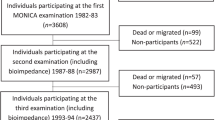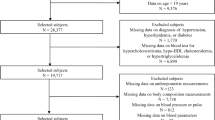Abstract
OBJECTIVES: The ideal index for leanness and obesity in epidemiological studies should correlate strongly with body weight and with a direct measure of fat while minimizing the influence of height. The preferred index is expected to show meaningful associations with subsequent mortality. Our aims were to compare weight/height, weight/height2 (body mass index or BMI), and weight/height3 as candidates for this index.
DESIGN: We analysed cross-sectional data from surveys of 6948 adults (3334 men (mean age 43 y, mean BMI 24.8 kg/m2), and 3614 women (mean age 42 y, mean BMI 24.3 kg/m2)) in Busselton, Australia whose weight, height, triceps skinfold, and cardiovascular risk factors were measured from 1966 through to 1978. In these same subjects we studied the mortality risks of indices of obesity using Cox regression analysis for survival time from first survey to death, or to follow up at the end of December 1995, after adjustment for age. Subjects dying within 5 y of the baseline survey were excluded from the analysis to avoid the bias of concurrent illness. We also studied subgroups including never smokers, subjects with no heart disease, and subjects<60 years of age at first survey.
RESULTS: In men, weight/height2 met the criteria for a satisfactory index in that there was a very strong correlation with triceps skinfold, and a negligible correlation with height. For women, weight/height was as good a measure as weight/height2, with both having strong correlations with triceps skinfold, and minimal correlations with height. Weight/height2 as a predictor of mortality in men of all ages showed the typical U-shaped associations that were similar and consistent and of variable statistical significance. The significances of the hazard ratio curves were the strongest for cardiovascular disease deaths (all men P=0.001; men without heart disease at baseline P<0.001; never smoking men P=0.007). In never smoking men there was a near linear positive relationship with all-cause mortality (P=0.018). In women weight/height2 showed no consistent associations with mortality. There was a shallow U-shaped relationship with all-cause mortality (P=0.087), also seen in never smoking women (P=0.075). In assessing ‘ideal’ weight for height in this population, a weight/height2 of 25 kg/m2 (range 22.5–27.5 kg/m2) is appropriate. Weight/height and mortality showed very similar patterns in men to weight/height2 with quite similar levels of statistical significance. In women much more pronounced U-shaped curves were apparent in all groups and subgroups, with a significant all-cause mortality trend for all women (P=0.029) and never smoking women (P=0.034). In assessing ‘ideal’ weight for height a weight/height of 42.5 kg/m (range 35–50 kg/m) appears appropriate for men and women.
CONCLUSIONS: Weight/height2 is an appropriate index of leanness and obesity in males at all ages, whereas weight/height is at least as good an index for females. In mortality studies weight/height2 and weight/height predict mortality similarly in males, but weight/height is a better discriminant of mortality in females.
This is a preview of subscription content, access via your institution
Access options
Subscribe to this journal
Receive 12 print issues and online access
$259.00 per year
only $21.58 per issue
Buy this article
- Purchase on Springer Link
- Instant access to full article PDF
Prices may be subject to local taxes which are calculated during checkout



Similar content being viewed by others
References
Van Itallie TB . Health implications of overweight and obesity in the United States Ann Intern Med 1985 103: 983–988.
Hubert HB, Feinleib M, McNamara PM . Obesity as an independent risk factor for cardiovascular disease: a 26 year follow-up of participants in the Framingham Heart Study Circulation 1983 67: 968–977.
Kannel WB, D'Agostino RB, Cobb JL . Effect of weight on cardiovascular disease Am J Clin Nutr 1996 63 (Suppl 4): 19S–22S.
World Health Organisation . Obesity: preventing and managing the global epidemic. Report of a WHO consultation on obesity. World Health Organisation: Geneva 1997.
Billewicz WZ, Kemsley WFF, Thomson AM . Indices of adiposity Br J Prevent Soc Med 1962 16: 183–188.
Khosla T and Lowe CR . Indices of obesity derived from body weight and height Br J Prevent Soc Med 1967 21: 122–128.
Grimley Evans J and Prior IAM . Indices of obesity derived from height and weight in two Polynesian populations Br J Prevent Soc Med 1969 23: 56–59.
Keys A, Fidanza F, Ksarvonen MJ, Kimura N, Taylor HL . Indices of relative weight and obesity J Chron Dis 1972 2S: 329–343.
williamson DF . Descriptive epidemiology of body weight and weight change in US adults Ann Intern Med 1993 119: 646–649.
Bennett PH . Recommendations on the standardization of methods and reporting of tests for diabetes and its microvascular complications in epidemiologic studies Diabetes Care 1979 2: 98–104.
Lapidus L, Bengtsson C, Larsson B, Pennert K, Rybo E, Sjostrum L . Distribution of adipose tissue and risk of cardiovascular disease and death: a 12 year follow-up of participants in the population study of women in Gothenberg, Sweden Br Med J 1984 289: 1257–1261.
Larsson B, Svardsudd K, Welin L, Wilhelmsen L, Bjorntorp P, Tibblin G . Abdominal adipose tissue distribution, obesity, and risk of cardiovascular disease: 13 year follow-up of participants in the study of men born in 1913 Br Med J 1984 288: 1401–1404.
Knuiman M, Cullen KJ, Bulsara MK, Welborn TA, Hobbs MST . Mortality trends 1965 to 1989 in Busselton, the site of repeated health surveys and interventions Aust J Public Health 1994 18: 129–135.
Welborn TA, Cumpston GN, Cullen KJ, Curnow DH, McCall MG, Stenhouse NS . The prevalence of coronary heart disease and associated factors in an Australian rural community Am J Epidemiol 1969 89: 521–536.
Rose GA and Blackburn H . Cardiovascular survey methods. World Health Organisation, Geneva 1968 pp 94–96.
Cox R . Regression models and life tables (with discussion). J R Stat Soc 1972 1334: 187–220.
Chandler PJ and Bock RD . Age changes in adult stature; trend estimation from mixed longitudinal data Ann Hum Biol 1991 18: 433–440.
Stevens J, Car J, Pamuk ER, Williamson DF, Thun MJ, Wood JL . The effect of age on the association between body-mass index and mortality New Engl J Med 1998 338: 1–7.
Kushner RF . Body weight and mortality (leading article) Nutr. Rev. 1993 51: 127–136.
Barker DJP, Osmond C, Golding J . Height and mortality in the counties of England and Wales Ann Hum Biol 1990 17: 1–6.
Kannam JP, Levy D, Larson MG, Wilson PW . Short stature and risk for cardiovascular disease morbidity and mortality: The Framingham Heart Study. Abstract from the 65th Scientific Session of the American Heart Association 1992 pp 1300.
Hebert PR, Rich-Edwards JW, Manson JE, Ridker PM, Buring JE, Hennekens CH . Height and risk of future myocardial infarction. Abstract from the 64th Scientific Session of the American Heart Association 1991 p 138.
Han TS, Feskens EJM, Lean MJ, Seidell JC . Associations of body composition with type 2 diabetes mellitus Diabetic Med 1998 15: 129–135.
Acknowledgements
This work was supported by a grant from the Western Australian Health Promotion Foundation, and was conducted under the auspices of the Busselton Population Medical Research Foundation. The authors thank Mrs Helen Bartholomew for assistance with the computer programming, and Dr Max Bulsara and Nick Ward for earlier work on the project.
Author information
Authors and Affiliations
Rights and permissions
About this article
Cite this article
Welborn, T., Knuiman, M. & Vu, H. Body mass index and alternative indices of obesity in relation to height, triceps skinfold and subsequent mortality: the Busselton Health Study. Int J Obes 24, 108–115 (2000). https://doi.org/10.1038/sj.ijo.0801093
Received:
Revised:
Accepted:
Published:
Issue Date:
DOI: https://doi.org/10.1038/sj.ijo.0801093
Keywords
This article is cited by
-
Obesity increases the risk of conversion to total knee arthroplasty after unicompartimental knee arthroplasty: a meta-analysis
Knee Surgery, Sports Traumatology, Arthroscopy (2022)
-
Obesity does not adversely impact the outcome of unicompartmental knee arthroplasty for osteoarthritis: a meta-analysis of 80,798 subjects
International Journal of Obesity (2021)
-
The impact of body mass index on metatarsalgia surgical outcomes
International Orthopaedics (2019)
-
Patient Satisfaction and Its Influencing Factors of Microtia Reconstruction Using Autologous Cartilage
Aesthetic Plastic Surgery (2017)
-
The UCLA Body Project I: Gender and Ethnic Differences in Self-Objectification and Body Satisfaction Among 2,206 Undergraduates
Sex Roles (2007)



